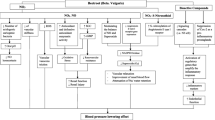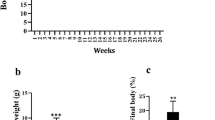Abstract
Health beneficial hypocholesterolemic and antioxidant influences of dietary fenugreek seeds (Trigonella foenum-graecum), garlic (Allium sativum), and their combination included along with a high cholesterol diet (HCD) were evaluated in Wistar rats. Dietary interventions were made by inclusion of 10 % fenugreek seed powder or 2 % garlic powder or their combination in HCD/normal diet groups. These dietary interventions significantly (p < 0.05) countered the hypercholesterolemia; the effect produced being more by the combination. LDL-associated cholesterol was particularly countered by 35, 15, and 50 % with fenugreek, garlic, and fenugreek + garlic, respectively, while HDL-associated cholesterol was restored. Elevated cholesterol:phospholipid ratio and atherogenicity index were also reversed by these dietary interventions, the effect being higher in the case of fenugreek + garlic. Hepatic cholesterol was lowered by dietary fenugreek, garlic, or their combination (p < 0.05). While the elevated myocardial cholesterol was countered by 28, 15, and 52 % with the respective interventions in HCD-fed situation, and cholesterol:phospholipid ratio was also beneficially modulated (p < 0.05) with higher benefit from the combination. Increase in lipid peroxides in liver and heart was effectively countered by dietary fenugreek, garlic, and fenugreek + garlic, with a restoration of vitamin E. The reduction in lipid peroxides was 34 and 57 % by fenugreek + garlic in these tissues, respectively. The diminished activity of glutathione peroxidase in serum, liver and heart, and of catalase in serum was effectively restored (p < 0.05) by these dietary interventions. This study indicated that dietary fenugreek and garlic may have higher cardio protective influence when consumed together, and this may be strategic to derive maximum nutraceutical benefit from these ingredients.

Similar content being viewed by others
References
Amani R, Sharifi N (2012) Cardiovascular disease risk factors. In: Gaze D (ed) The cardiovascular system—physiology, diagnostics and clinical implications. InTech, Croatia, pp 279–310
Srinivasan K (2006) Fenugreek (Trigonella foenum-graecum): a review of health beneficial physiological effects. Food Rev Int 22:203–224
Srinivasan K (2005) Role of spices beyond food flavouring: nutraceuticals with multiple health effects. Food Rev Int 21:167–188
Srinivasan K, Sambaiah K, Chandrasekhara N (2004) Spices as beneficial hypolipidemic food adjuncts: a review. Food Rev Int 20:187–220
Srinivasan K (2013) Dietary spices as beneficial modulators of lipid profile in conditions of metabolic disorders and diseases. Food Funct 4:503–521
Srinivasan K (2014) Antioxidant potential of spices and their active constituents. Crit Rev Food Sci Nutr 54:552–572
Folch J, Lees M, Sloane-Stanley GH (1957) A simple method for the isolation and purification of total lipids from animal tissues. J Biol Chem 226:497–509
Searcy RL, Bergquist LM (1960) A new color reaction for the quantitation of serum cholesterol. Clin Chim Acta 5:192–197
Warnick GR, Albers JJ (1978) A comprehensive evaluation of heparin-manganese procedure for estimating HDL-cholesterol. J Lipid Res 19:65–76
Stewart CJM (1980) Colorimetric determination of phospholipids with ammonium ferrothiocyanate. Anal Biochem 104:10–14
Fletcher MJ (1968) A colorimetric method for estimating serum triglycerides. Clin Chim Acta 22:393–397
Aebi H (1984) Catalase in vitro. Methods Enzymol 105:121–126
Flohe L, Otting F (1984) Superoxide dismutase assays. Methods Enzymol 105:93–104
Flohe L, Gunzler WA (1984) Assays of glutathione peroxidase. Methods Enzymol 105:114–121
Carlberg I, Mannervik B (1985) Glutathione reductase. Methods Enzymol 113:484–490
Warholm M, Guthenberg C, Bahr CV, Mannervik B (1985) Glutathione transferase from human liver. Methods Enzymol 113:499–504
Beutler E, Duron O, Kelly BM (1963) Improved method for the determination of blood glutathione. J Lab Clin Med 61:882–888
Omaye ST, Turnbull JD, Sauberlich HE (1973) Selected methods for the determination of ascorbic acid in animal cells, tissues and fluids. Methods Enzymol 62:3–11
Zaspel BJ, Csallany AS (1983) Determination of and α;-tocopherol in tissues and plasma by HPLC. Anal Biochem 130:146–150
Thimmayamma BVS, Rao P, Radhaiah G (1983) Use of spices and condiments in the dietaries of urban and rural families. Indian J Nutr Diet 20:153–162
Jenkins DJ, Kendall CWC, Axelsen M, Livia SA, Vuskan A, Vuskan V (2000) Viscous and non viscous fibre, nonabsorbable and low glycemic index carbohydrates, blood lipids and coronary heart disease. Curr Opin Lipidol 11:49–56
Butt MS, Shahzadi N, Sharif M, Nasir M (2007) Guar gum: a miracle therapy for hypercholesterolemia, hyperglycemia and obesity. Crit Rev Food Sci Nutr 47:389–396
Bhat BG, Sambaiah K, Chandrasekhara N (1985) The effect of feeding fenugreek and ginger on bile composition in the albino rat. Nutr Rep Int 32:1145–1151
Gonen A, Harats D, Rabinkov A, Miron T, Mirelman D, Wilchek M, Weiner L, Ulman E, Levkovitz H, Ben-Shushan D, Shaish A (2005) The antiatherogenic effect of allicin: possible mode of action. Pathobiology 72:325–334
Mahfouz MM, Kummerow FA (2000) Cholesterol rich diets have different effects on lipid peroxidation, cholesterol oxides and antioxidant enzymes in rats and rabbits. J Nutr Biochem 11:293–302
Reddy RLR, Srinivasan K (2011) Hepatoprotective and antioxidant effect of fenugreek (Trigonella foenum-graecum) seeds in mice under lithogenic condition. J Food Biochem 35:1619–1626
Ravikumar P, Anuradha CV (1999) Effect of fenugreek seeds on blood lipid peroxidation and antioxidants in diabetic rats. Phytother Res 13:197–201
Anuradha CV, Ravikumar V (2001) Restoration of tissue antioxidants by fenugreek seeds (Trigonella foenum-graecum) in alloxan diabetic tars. Indian J Physiol Pharmacol 45:408–420
Genet S, Kale RK, Baquer NZ (2002) Alterations in antioxidant enzyme and oxidative damage in experimental diabetic rat tissues: effect of vanadate and fenugreek (Trigonella foenum-graecum). Mol Cell Biochem 236:7–12
Anwar MM, Meki AR (2003) Oxidative stress in streptozotocin induced diabetic rats: effects of garlic oil and melatonin. Comp Biochem Physiol Mol Integr Physiol 135:539–547
El-Demerdash FM, Yousef MI, El-Naga NI (2005) Biochemical study on the hypoglycaemic effects of onion and garlic in alloxan induced diabetic rats. Food Chem Toxicol 43:57–639
Manjunatha H, Srinivasan K (2007) Hypolipidemic and antioxidant effects of dietary curcumin and capsaicin in induced hypercholesterolemic rats. Lipids 42:1133–1142
Balasenthil S, Ramachandran CR, Nagini S (2001) S-allylcysteine, a garlic constituent, inhibits 7,12-dimethylbenz[a]anthracene-induced hamster buccal pouch carcinogenesis. Nutr Cancer 40:165–172
Acknowledgments
The first author (PM) is grateful to the Indian Council of Medical Research, New Delhi for the award of Senior Research Fellowship.
Conflict of interest
None.
Compliance with Ethics Requirements
All institutional and national guidelines for the care and use of laboratory animals were followed.
Author information
Authors and Affiliations
Corresponding author
Rights and permissions
About this article
Cite this article
Mukthamba, P., Srinivasan, K. Beneficial hypolipidemic influence of a combination of dietary fenugreek (Trigonella foenum-graecum) seeds and garlic (Allium sativum) in induced hypercholesterolemic rats. Eur Food Res Technol 240, 1049–1058 (2015). https://doi.org/10.1007/s00217-014-2408-4
Received:
Revised:
Accepted:
Published:
Issue Date:
DOI: https://doi.org/10.1007/s00217-014-2408-4




